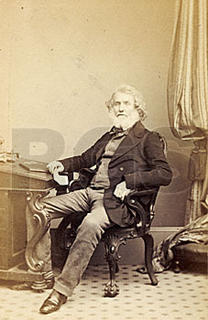Everest

Sir George Everest
© Royal Geographical Society
George Everest was the Surveyor General of India who was instrumental in giving push to the "Great Triangulation Survey" by which they determined the exact shape of the Indian subcontinent. It was the most detailed survey ever conducted and was very detailed and scientific for its time. It was started before George Everest's time but he was the one who gave it the push and moved it forward. The survey mapped South India to start with and then moved north. They used gigantic equipment which required many men at a time to move it. George Everest retired when they started mapping the "white uprisings" they could see from the upper regions of (now) Uttar Pradesh. He was succeeded by Andrew Waugh, the next Surveyor General of India.
Andrew had a human computer - a Bengali of the name of Sikhdar. Sikhdar started measuring the heights of these uprisings in 1850 using the triangulation techniques of George Everest. As they measured the mountains, they gave them "working names", Everest was called Peak XV, it was the 15th peak measured by Sikhdar. Their first calculations were incorrect and Kanchenjunga was calculated to be higher than Peak XV. Andrew Waugh was excited that he had finally discovered the highest peak in the world. Yet, he kept it to himself.
The year 1852 came, and Peak XV finally asserted itself. Sikhdar came running into Waugh's tent one evening (they were camped in North UP, doing the survey). Sikhdar was very excited and said that he was now sure that Peak XV was higher than Kanchenjunga...and that Peak XV was 29,002 feet. Andrew Waugh dithered. How was Sikhdar so sure ? Sikhdar was asked to rework his numbers again and again. Despite trying to find every possible flaw in Sikhdar's logic and numbers, Peak XV kept emerging as the highest. The time had come for Peak XV to make its mark on mankind and no amount of flaw finding by Andrew Waugh to delay that.
Andrew Waugh took 4 years, till 1856, to finally be convinced that Sikhdar was correct. That Peak XV was indeed 29,002 feet, many many feet higher than the rest. He declared this to the high command in Great Britain. Andrew Waugh also recommended that the mountain be named Mount Everest after George Everest, in recognition of the latter's contribution to the triangulation survey.
A fierce controversy raged on this. Mountains were, as per practice, named after local names. The controversy lasted 8 years...till finally it was christened Mount Everest.
Yet, George Everest never saw Mount Everest. So that is Mount Everest....the same mountain as Peak XV, the same mountain as Chomolungma (the Tibetans) and the same Mountain as Sagarmatha (the Nepali). And baby....the same mountain as George Mallory....smile...
PS : There is one mountain which is still named by its original "working name"...like Peak XV was for Everest. Can you guess which one ..smile. It seems odd isn’t it that we never question why mountains are called what they are ? smile.....Ever thought why K2 is called that ? It was the 2nd mountain surveyed in the Karakoram range....smile
-- Sandeep Chopra, 21 July, 2003

0 Comments:
Post a Comment
<< Home